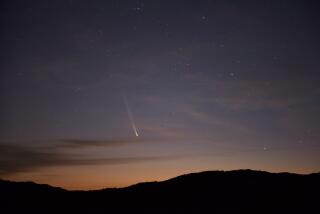Mysterious light streaks across Southern California’s night sky. What was it?
What the heck was that?
Videos posted by Southern Californians on social media Wednesday night showed a celestial object streaking overhead before disintegrating into dazzling pieces. Residents from all over the Southland logged their sightings, and the American Meteor Society fielded witness reports ranging from Santa Barbara to Imperial Beach, and as far inland as Bakersfield and Indio.
Cami Buckman, 23, of El Segundo, said she noticed the impromptu light show while driving on the 405 Freeway near Los Angeles International Airport.
“I never see these kinds of things, so at first I thought it was a plane,” said Buckman, an editor for “L.A. Times Today,” a Spectrum News show focusing on L.A. Times news. “But then, it looked like it was breaking apart, which was when it caught my attention more.”
As she watched, the object “slowly became this long line of fragmented lights, and then it disappeared.”
“My first thought was, ‘UFO?’” she said with a laugh. “But then I realized it was just a meteor.”
Actually, it’s unclear exactly what the object was. But Mike Hankey, operations manager with the American Meteor Society, said his money was on some kind of space debris, based on the speed of the object and how long it was visible.
“It’s more likely to be space debris than a weird, rogue, super-slow asteroid,” he said.
Another piece of evidence, he said, was how the object broke apart. When something is made of a hard material like solid ice, rock or metal, there’s usually “a big ball that blows up,” he said.
“Here, there was nothing like that,” he said. “There’s no burst. It more just sort of falls apart, which is also very characteristic of a space object like a satellite or rocket engine or something like that.”
Paul Lynam, an astronomer at the Lick Observatory near San Jose, said all the evidence he’s seen also would indicate “that this was more likely a piece of space junk.”
He estimated the object’s size was probably “a matter of inches or less.”
“The typical shooting star you see is only like a grain of sand most of the time. ... It’s a good demonstration of the physical forces at work when you see these spectacular things,” he said.
Both natural and man-made objects can cause bright lights in the sky when they enter the atmosphere.
Naturally occurring meteors are far from a rare sight in the Southland. The Quadrantids shower peaked earlier this month, and another — the Lyrids — will be active in April, according to Griffith Observatory.
Although events like Wednesday’s also are not uncommon from a global perspective, Lynam said that those who got to see it were very lucky.
“The fact it was over a major urban populated area with the moon setting, it was tailor-made for people to get a spectacular view,” he said.
More to Read
Sign up for Essential California
The most important California stories and recommendations in your inbox every morning.
You may occasionally receive promotional content from the Los Angeles Times.











